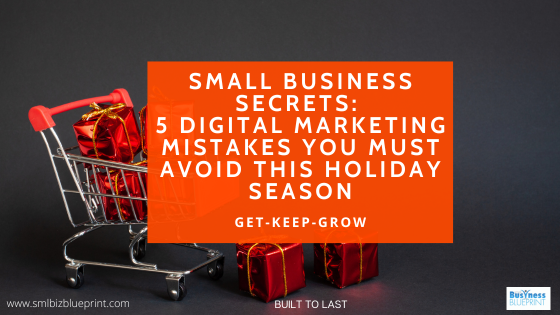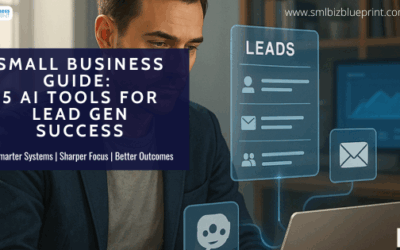The holiday season is a critical time for small businesses to shine.
It’s a period of heightened consumer activity, with people eagerly searching for the perfect gifts and deals. To make the most of this opportunity, effective digital marketing is essential.
However, just as the holidays can bring joy, they can also bring pitfalls that can hinder your success.

This in-depth guide will delve into the top five digital marketing mistakes your small business should avoid during the holiday season. You’ll learn what to do, why it matters, and how to do it right.
Neglecting Mobile Optimization
What to Do:
Ensure your website and email campaigns are mobile-friendly and optimised for a seamless mobile experience.
Why It Matters:
Mobile usage soars during the holidays. In 2021, 56.7% of all holiday shopping traffic came from mobile devices (Statista). Neglecting mobile optimisation can lead to frustrated users and missed sales opportunities.
How to Do It Right:
Invest in responsive design, optimise loading times, and create mobile-friendly email templates. Test your website and emails on various devices to ensure a flawless user experience. Don’t underestimate the significance of mobile during the holiday rush.
The holiday season brings a significant shift in consumer behaviour. Shoppers are constantly on the move, and their smartphones are their constant companions.
If your website isn’t mobile-friendly, you risk losing many potential customers. But it’s not just about having a mobile-friendly website; it’s about providing an exceptional user experience on mobile devices.
Imagine a shopper clicking on an enticing holiday promotion link only to find a website that loads slowly, with buttons too small to tap accurately. Frustration sets in, and they abandon your site in search of a competitor’s more user-friendly alternative.
This scenario can be disastrous for your holiday sales.
To avoid this mistake, invest in responsive web design. Ensure your website adapts seamlessly to different screen sizes, providing an optimal user experience on smartphones and tablets.
Speed is of the essence, so optimise your website’s loading times to prevent potential customers from bouncing off to faster-loading sites.
In addition to your website, pay special attention to your email marketing campaigns. More than 50% of emails are opened on mobile devices (EmailMonday). If your emails are not mobile-friendly, your holiday promotions might go unnoticed or unopened.
Create mobile-responsive email templates and test them rigorously to guarantee they render correctly on various devices.
Remember, during the holiday season, a smooth mobile experience is not just a nice-to-have; it’s necessary for small businesses to thrive.
Ignoring Social Media Engagement
What to Do:
Actively engage with your audience on social media platforms, fostering meaningful connections.
Why It Matters:
Over 3.6 billion people use social media worldwide (Statista). Neglecting social media engagement means missing out on valuable interactions and brand exposure during the holiday season.
How to Do It Right:
Post consistently with captivating content, respond to comments and messages promptly, and use social media ads strategically to reach a broader audience. Share user-generated content to build trust and encourage engagement.
Social media is the beating heart of digital communication, and during the holidays, it’s where your customers gather. It’s a place where people share their holiday shopping triumphs, seek recommendations, and engage with brands.
Ignoring social media during this period is akin to turning your back on a bustling marketplace.
The mistake here is not just about maintaining a presence on social media but failing to engage with your audience actively. It’s about more than just posting product listings; it’s about creating meaningful connections with your customers.
Consistency is key when it comes to social media engagement. Regularly post content that resonates with your audience, such as holiday gift guides, festive tips, and heartwarming stories.
Encourage your followers to share their holiday experiences and interact with your posts by asking questions or running holiday-themed contests.
In addition to organic content, consider using social media advertising to extend your reach.
Platforms like Facebook and Instagram offer targeted ad options that can put your products in front of potential customers actively searching for holiday gifts.
Prompt and genuine responses to comments and messages are vital. When a customer reaches out on social media, they expect a quick reply. Failure to respond promptly can result in lost sales and a tarnished brand image.
Ensure your social media team is ready to provide excellent customer service, even during the holiday rush.
Furthermore, harness the power of user-generated content. Encourage your customers to share their holiday purchases and experiences with your products.
Repost their content on your social media channels, accompanied by a heartfelt thank-you message. This builds trust and serves as free advertising, as satisfied customers become your brand advocates.
In the holiday season, social media is your megaphone to the world. Embrace it, engage with your audience authentically, and watch your brand’s visibility and trustworthiness grow.

Failing to Plan Early
What to Do:
Start planning your holiday marketing campaigns well in advance, ideally six months before the holiday season.
Why It Matters:
A survey by the National Retail Federation found that 40% of consumers begin holiday shopping before Halloween. Early planning allows for a well-thought-out and stress-free execution of your holiday marketing strategy.
How to Do It Right:
Create a detailed holiday marketing calendar, set clear goals, and allocate budgets early.
Collaborate with your team to ensure seamless execution. Consider launching teaser campaigns to build anticipation and excitement among your audience.
Planning is not just a smart strategy; it’s an absolute necessity for holiday marketing. The mistake here is procrastination and failing to recognise that the holiday season requires meticulous preparation.
Picture this: it’s mid-November, and you’ve just realised that your holiday marketing campaigns are nowhere near ready. Panic sets in as you rush to create content, design graphics, and set up promotions.
The result? A haphazard marketing strategy that lacks coherence and effectiveness.
To avoid this pitfall, start planning your holiday marketing campaigns well in advance, ideally six months before the holiday season begins. This early start gives you the time to craft a well-thought-out strategy, create compelling content, and coordinate effectively with your team.
Begin by creating a detailed holiday marketing calendar. This calendar should outline every step of your holiday marketing strategy, from content creation and email campaigns to social media posts and advertising schedules.
By breaking down your plan into actionable tasks, you can ensure that nothing falls through the cracks.
Set clear goals for your holiday campaigns. Do you want to increase sales by a certain percentage, grow your email subscriber list, or boost social media engagement? Having well-defined objectives will guide your efforts and help you measure success.
Budgeting is another critical aspect of early planning. Determine how much you’re willing to allocate to your holiday marketing efforts.
Remember that effective marketing often requires investments in advertising, content creation, and possibly additional staff for the holiday rush.
Collaboration is key. Involve your team early in planning to ensure everyone is aligned with the holiday marketing strategy. Assign responsibilities and establish clear communication channels to facilitate smooth execution.
Consider launching teaser campaigns ahead of the holiday season. Teasers create anticipation and excitement among your audience, priming them for your main holiday promotions.
Teasers can include sneak peeks of upcoming deals, behind-the-scenes glimpses of holiday preparations, or teaser emails to your subscribers.
In summary, early planning sets the stage for a successful holiday season. It allows you to execute your marketing campaigns precisely, avoid last-minute stress, and capitalise on the full potential of the holiday shopping frenzy.
Overlooking Email Marketing
What to Do:
Harness the power of personalised and segmented email campaigns tailored to your audience’s preferences.
Why It Matters:
Email marketing remains one of the most effective ways to reach your audience during holidays. The average open rate for personalised emails is 18.8% (Marketing Dive).
How to Do It Right:
Segment your email list based on customer preferences and behaviour. Craft compelling subject lines, offer exclusive holiday promotions to subscribers, and use A/B testing to refine your email content and timing.
Email marketing has stood the test of time and remains a formidable tool for connecting with your audience during the holiday season. The mistake here is not in using email but underestimating its potential and failing to execute it effectively.
During the holiday season, inboxes fill up with promotional emails. Your email marketing must be highly targeted, personalised, and engaging to stand out.
Start by segmenting your email list. Your subscribers are not all the same. Segment them based on past purchase behaviour, preferences, and engagement level.
This allows you to send highly relevant content and offers to different segments, increasing the likelihood of conversion.
Subject lines are your email’s first impression. Craft compelling subject lines that pique curiosity, convey urgency, or solve a holiday-related problem.
Test different subject lines to see which ones resonate best with your audience.
Exclusive holiday promotions can work wonders in your email campaigns. Offer special discounts or early access to holiday deals to your email subscribers. Make them feel like VIPs who receive exclusive benefits.
Personalisation is crucial. Address recipients by their names and tailor your content to their interests and preferences. Use dynamic content to show different products or offers based on each recipient’s past behaviour.
A/B testing is your ally in optimising email campaigns. Experiment with different email content, visuals, and send times to determine what works best for your audience.
Continuously analyse the results and adjust your strategies accordingly.
Remember that your email frequency can increase during the holiday season. However, avoid bombarding your subscribers with daily emails, as this can lead to unsubscribes or being marked as spam.
Strike a balance between staying top-of-mind and respecting your audience’s inbox.
In conclusion, email marketing remains a powerful tool to connect with your audience during the holiday season. The key is personalisation, segmentation, and a well-crafted strategy that ensures your emails stand out amidst the holiday email deluge.

Neglecting Analytics and Data
What to Do:
Regularly analyse and track the performance of your marketing campaigns using data-driven insights.
Why It Matters:
Data-driven decisions lead to better ROI. Marketers who use data-driven personalisation see a 5-15% increase in revenue (Forrester).
How to Do It Right:
Utilise tools like Google Analytics, Facebook Insights, and email marketing platforms to track key metrics. Adjust your strategies based on the insights gained and conduct a thorough post-holiday analysis to inform future campaigns.
Data is your compass in digital marketing, and neglecting it is akin to navigating a ship without a map. The mistake here is not in collecting data but in failing to utilise it to guide your decisions and maximise your marketing efforts.
Data-driven marketing is about making informed decisions based on facts and insights rather than relying on intuition alone. During the holiday season, when competition is fierce, data-driven decisions can give you a competitive edge.
Start using tools like Google Analytics to track key metrics such as website traffic, conversion, and bounce rates. Pay close attention to data related to your holiday campaigns.
Which products are driving the most sales? Which marketing channels are delivering the highest ROI? Analyse this data to allocate your resources effectively.
Facebook Insights can provide valuable data on the performance of your social media campaigns. Monitor engagement metrics, such as likes, shares, and comments, to gauge the effectiveness of your content.
Identify your top-performing posts and use them as a template for future content.
Email marketing platforms offer insights into email campaign performance. Track metrics like open rates, click-through rates, and conversion rates. Identify which email subject lines, content, and offers resonate most with your audience.
A/B testing is a powerful tool for data-driven optimisation. Use it to test different elements of your campaigns, such as ad copy, visuals, and email content. Analyse the results to refine your strategies continuously.
Regularly review your data as the holiday season progresses and adjust your strategies accordingly. If you notice a particular product category performing exceptionally well, consider allocating more resources to promote it. Adjust your budget to focus on what works best if a specific marketing channel is underperforming.
After the holiday season, conduct a thorough post-mortem analysis. What were the overall outcomes of your holiday marketing efforts? What worked exceptionally well, and what needs improvement? Use these insights to inform your strategies for the next holiday season.
Must-Haves
A successful digital marketing strategy for the holiday season requires careful planning and execution.
Here are the top three must-haves:
Mobile Optimization:
In today’s mobile-centric world, having a mobile-friendly website and mobile-optimized marketing campaigns is crucial. Ensure your website loads quickly on mobile devices and your emails are responsive. Mobile optimisation ensures a seamless shopping experience for customers on smartphones and tablets, which are widely used for holiday shopping.
Early Planning:
Starting your holiday marketing planning well in advance is essential. Ideally, begin at least six months before the holiday season. This allows you to create a comprehensive marketing calendar, set clear goals, allocate budgets, and coordinate with your team effectively. Early planning ensures that your campaigns are well-thought-out and executed without last-minute stress.
Data-Driven Decision Making:
Data is the key to optimising your holiday marketing strategy. Use analytics tools like Google Analytics, Facebook Insights, and email marketing platforms to track and analyse key metrics. This data will guide your decisions, helping you allocate resources effectively and refine your strategies based on real-time insights. Data-driven marketing leads to better ROI and more successful holiday campaigns.
Additional Options
Chatbots and AI-Powered Customer Support:
Implementing chatbots and AI-driven customer support can be a game-changer during the holiday season. These tools can handle routine customer inquiries, provide instant assistance, and even process orders, freeing your human support team to focus on more complex issues. Chatbots can operate 24/7, ensuring customers receive prompt assistance, even during non-business hours.
User-Generated Content Campaigns:
Encourage your customers to become your brand advocates by running user-generated content (UGC) campaigns. Ask them to share their holiday-related experiences with your products or services on social media using a specific hashtag. Repost their content on your official channels with their permission. UGC campaigns build trust and authenticity as potential customers see real people enjoying your offerings.
Personalised Video Messages:
Stand out from the competition by sending personalised video messages to your loyal customers. Use their names, reference past purchases, and wish them a happy holiday season. Personalised videos create a memorable and emotional connection, strengthening customer loyalty. Tools like Loom and BombBomb make creating and sending personalised video messages easy.
These additional Options can add a unique touch to your holiday marketing strategy, fostering deeper connections with your audience and enhancing the overall customer experience.
In summary, data-driven marketing is the compass that keeps your holiday marketing campaigns on course. Don’t just collect data; use it to make informed decisions that optimise your marketing efforts and boost your holiday season ROI.
By avoiding these five digital marketing mistakes, you’ll set your small business on the path to holiday season success. Successful digital marketing requires planning, adaptability, and a commitment to continuous improvement.
Frequently Asked Questions
Q1: What are some common mobile optimisation mistakes?
A1: Common mobile optimisation mistakes include slow-loading websites, non-responsive design, and small, hard-to-click buttons. Prioritise a user-friendly mobile experience to capture mobile shoppers. Conduct user testing to identify and rectify issues.
Q2: How can I measure the effectiveness of my social media engagement?
A2: Track metrics such as engagement rate, click-through rate, shares, and comments on your posts. Use analytics tools like Facebook Insights and Google Analytics to gain valuable insights.
Q3: When should I start planning my holiday marketing campaigns?
A3: Ideally, plan your holiday campaigns at least six months in advance to ensure a well-executed strategy. However, even if you’re starting later, it’s never too late to plan and optimise your holiday marketing efforts.
Q4: What types of emails work best for holiday marketing?
A4: Personalized promotional emails, holiday-themed newsletters, and cart abandonment emails with special holiday offers tend to perform well during the holiday season.
Q5: Which analytics tools should I use for tracking digital marketing performance?
A5: Utilize Google Analytics, Facebook Insights, and email marketing platforms to track digital marketing performance.
In conclusion, the holiday season presents small businesses with a tremendous opportunity for growth.
By avoiding these digital marketing mistakes and following the right strategies, you’ll be well-positioned to maximise your holiday sales and engage effectively with your audience.
Start planning now, ensure mobile optimisation, and watch your holiday season success soar.
Sign up for our newsletter today.




